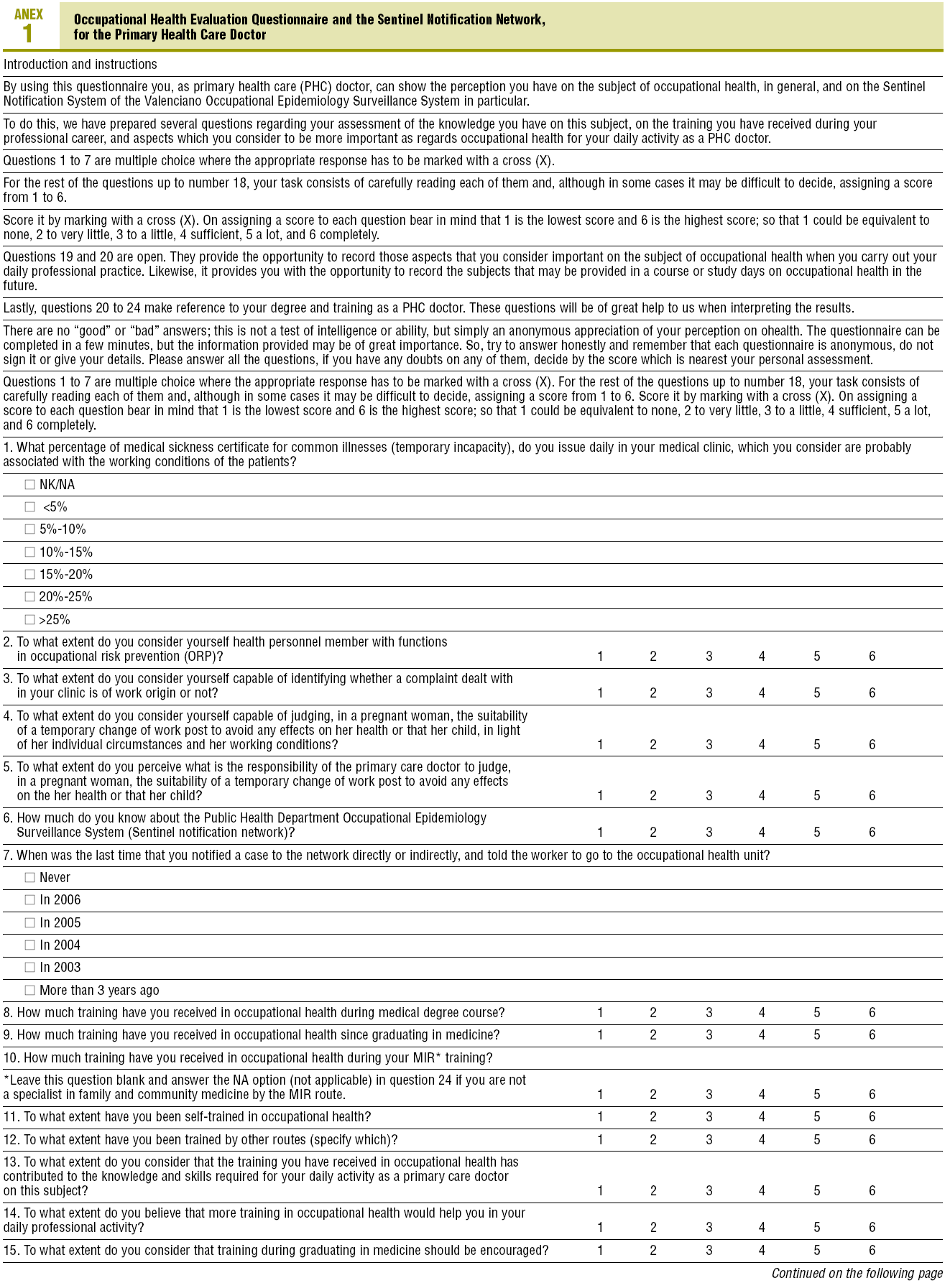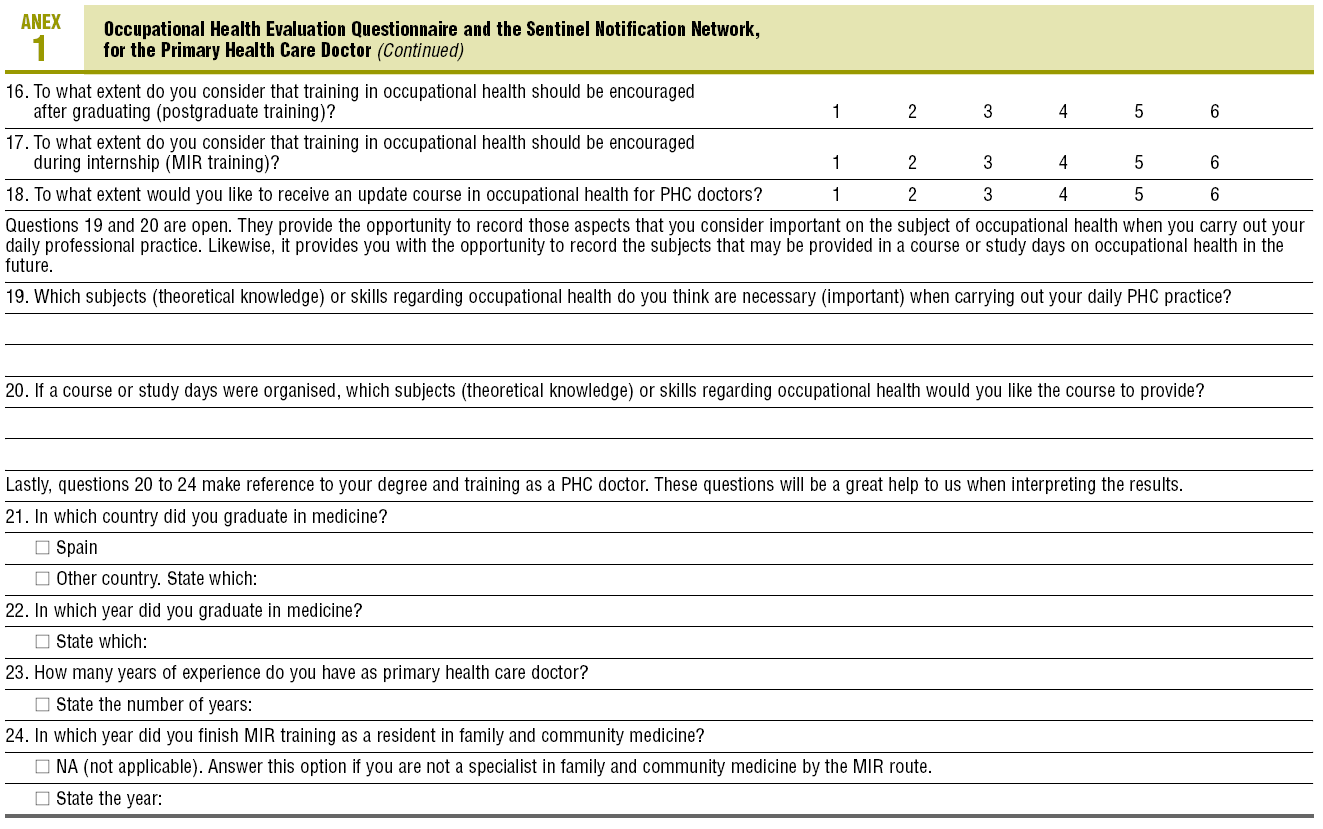Key Points
• Recent legal requirements give a key role to primary care medical staff in the occupational health system.
• The study by Santibáñez et al identifies a low perception of belonging to occupational risk prevention, moderate ability to perform some occupational health functions and a deficiency in the training received in this field.
• Some measures could help to improve the three indicators are the new family and community medicine program, the setting up of occupational health units in the geographical areas not covered and the development of coordination systems between the leading players in occupational health (benefit societies and prevention services) and primary health care.
Even though they might have different health organisational structures, a substantial number health problems associated with work are attended in primary health care (PHC) in most countries.1 In the Spanish system, the responsibilities of PHC professionals cover many areas in connection with occupational health, such as treating injuries due to an accident at work and occupational diseases (OD) of employees, including employees whose companies have chosen the Social Security for this provision--unlike those who belong to an accidents at work and occupational diseases benefit societies (MATEP)--or workers collectives and workers who do not have occupational health insurance--like the majority of the self-employed, people subjected to the Social Security special regime for home employees or those who work without a contract--, but who have occupational health related problems. On the other hand, a significant part of their activities are directed at caring for diseases of occupational origin which escape the appropriate care system, MATEPs. A study carried out in Catalonia has estimated that occupational illnesses attended to in PHC could be as much as 16% of the care load.2
Two legal regulations have recently been published which include measures directed at increasing notifications of OD, and give a key role to Public Health System professionals, particularly those in primary care. The first of these, Royal Decree 1299/2006,3 updates the definition of OD and establishes new criteria for notifying and recording them. This rule stipulates that medical personnel of the Public Health System, when suspecting an OD, will notify this to the responsible organisation in each autonomous community, the Social Security National Institute (INSS) or the corresponding benefit society.
More recently, the second measure is set out in the Resolution of 19 September 2007, by the Secretary of State for Social Security.4 According to this Resolution, benefit societies must send all files which they rejected as occupational diseases to the provincial managers of the INSS. Supervision by the INSS will take into consideration cases where there may be evidence associated with work. Thus, it is understood that it will include evidence where there may be documents in the files which will presumably mention that there may be an OD, such as, for example, reports by PHC professionals that mention the possible link between the health problem and work activity.
In this context of increased responsibilities of PHC in occupational health, the study by Santibáñez et al,5 which is published in this issue of Atención Primaria, approaches this subject from the perspective of PHC professionals, particularly in relationship to their role in the occupational health system, their level of professional ability, as well the training received in this field. Although, the study covered a limited geographical area, the data it provides are of great interest as they are the only ones published in our country. The results give some points for reflection and may lead to some strategies to improve the quality of care of occupational health in the primary health care setting.
The primary results presented by the authors show a low perception of belonging to the occupational risk prevention health system by the professionals surveyed, a moderate ability to perform some of the functions of occupational health they carry out and a clear deficiency in the training received in this field. Up to what point can these results be generalised to all PHC medical staff in the country? The answer may be partly depend on the existence of occupational health units (USL) in the area referred to. Some autonomous communities have USLs and, although there are differences between them, the majority carry out PHC support functions. In Catalonia, for example, there are currently 8 units attached to the Public Health Department of the autonomous government, with functions that include managing a epidemiology surveillance system of health problems associated with work notified by doctors from primary health care teams, as well giving advice, technical support and training on questions of occupational health to professionals in this health setting. The URLs were established in 1990 and the notified cases having been increasing, going from an incidence of 4, to 7.1 per 10 000 Social Security contributors between 2001 and 2004.6 Although it is one aspect which needs to be evaluated, it seems reasonable to think that the inclusion of these units in geographical settings where they do not exist, could help to improve the 3 indicator groups approached in the study by Santibáñez et al.
One of the main results of the study is the lack of occupational health training expressed by the participants; the deficiency is perceived in all academic levels, but particularly during MIR training. In this sense, the new program of the family and community medicine specialty, which came into force for the 2004/2007 course, has to help in improving training and the level of ability of future professionals. The 4 objectives that must be achieved on completing MIR training as regards the "care of the workers" section, are: a) to recognise the impact on the health of the workers and/or the conditions in which these effects develop and to identify the risk factors; b) to manage the legal, administrative, institutional, and relational aspects of the representatives involved in the occupational health organisation; c) to know and update the health problems linked to working conditions, depending on the specific risks and work activities; and d) to offer advice and basic information to the user, as regards the clinical prevention and administrative aspects, depending on their individual conditions and the associated risk factors.
Finally, another point for reflection from the results of the study, is the lack of contact between major occupational health organisations (prevention services and MATEP) and PHC professionals, an aspect which could be associated with the low feeling of belonging to the system by the doctors surveyed. With the exception of some isolated initiatives, such as that by the Institut Català d´Avaluacions Mèdiques (Catalonian Institute of Medical Assessments)--an organisation which assesses occupational diseases--, by reforming the "underlying cause network" which has formalised the exchange of information between PHC and the benefit societies in cases of temporary incapacity, there is no other known initiative that connects PHC professionals with the managers of company risk prevention services, despite the various activities that could benefit from this relationship, such as re-establishing the work post after an illness or accident,8 care of particularly sensitive workers, those who work in companies with occupational illness Social Security cover or those who have disorders that do not fulfil the criteria of an OD, but where work factors are involved.
Material para internet











